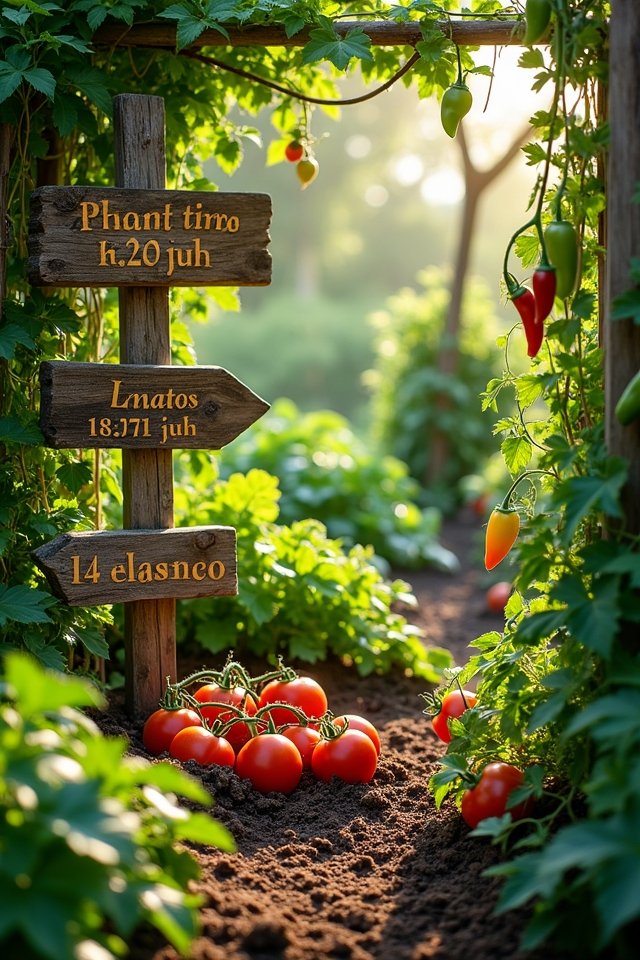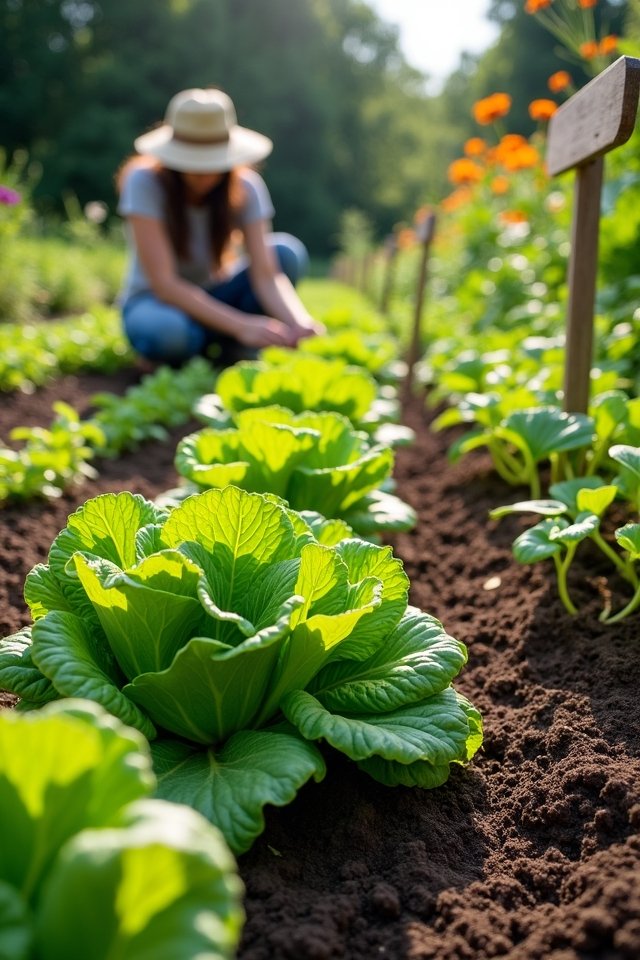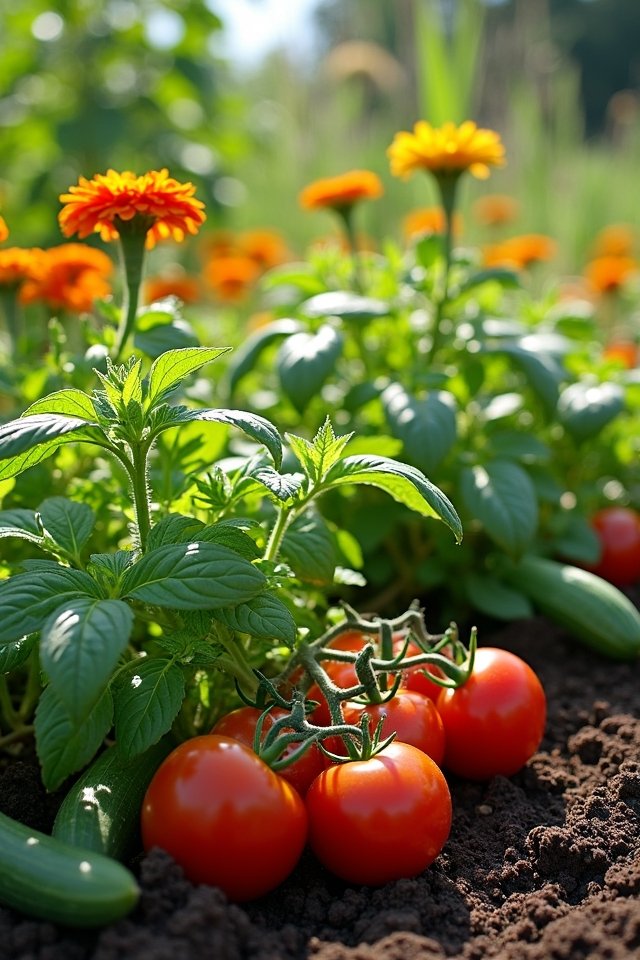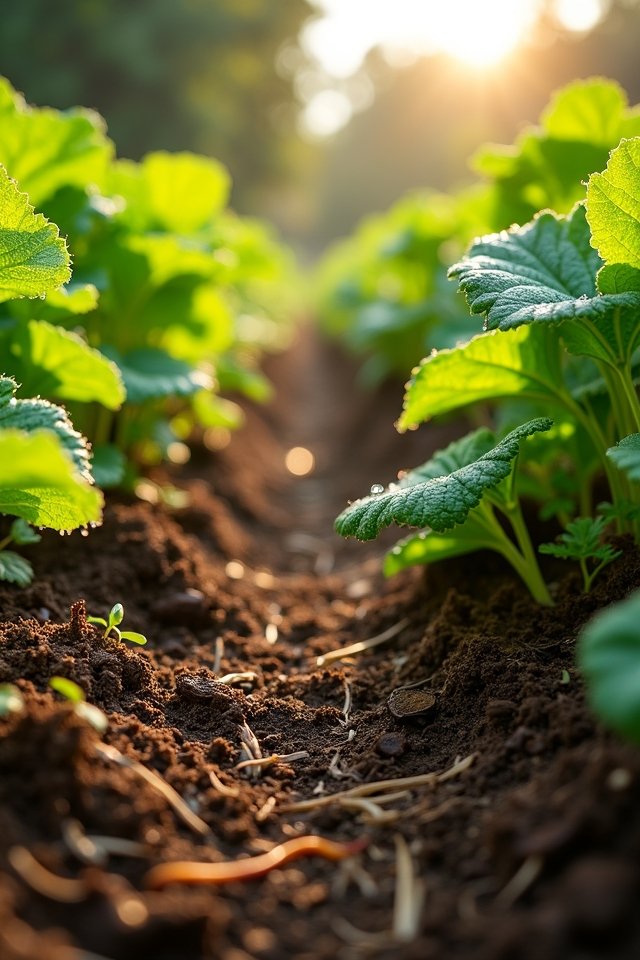Want a garden that’s bursting with flavor and color? Start by choosing seasonal crops like zesty summer tomatoes and hearty autumn kale! Rotate your plants to keep the soil happy and healthy. Have fun with companion planting—basil loves tomatoes, and marigolds hate pests! Don’t forget to mulch for moisture and weed control, plus keep an eye on your soil’s health. Ready to see your garden thrive? There’s so much more to discover!
Choose the Right Seasonal Crops

When you plan your garden, remember that choosing the right seasonal crops can make all the difference! It’s like picking the stars for your constellation of flavors. Immerse yourself in the world of crop selection based on seasonal timing! In spring, sow vibrant radishes and delicate peas that spring to life with the warmth. Summer’s sunshine calls for tomatoes that burst with juiciness and peppers that pack a punch! As autumn approaches, think of cozy pumpkins and hearty kale to welcome the chill and make your soups sing! By paying attention to seasonal timing, you’ll create a garden that thrives, not just survives! So grab your trowel and get excited—an innovative garden awaits you, bursting with color and flavor!
Implement Crop Rotation Strategies

After you’ve picked those glorious seasonal crops, it’s time to think about how to keep your garden healthy and vibrant year after year. Implementing crop rotation strategies is key! By alternating what you plant each season, you boost soil diversity and reduce pesky pests. Imagine swapping out those delicious tomatoes for nutrient-loving beans the next year! This simple shift breaks disease cycles and encourages a flourishing ecosystem in your garden. You’ll keep your soil rejuvenated, ensuring it remains rich and fertile. Plus, it gives you a chance to experiment with new varieties—who wouldn’t want to try growing exotic eggplants or zesty peppers? So, roll up your sleeves, get creative with your rotation plan, and watch your garden thrive!
Practice Companion Planting

You’re diving into the vibrant world of companion planting, right? This innovative technique’s like throwing a garden party where the guests actually help each other! Pair powerful herbs, like basil and tomatoes, to enhance their growth while warding off pesky pests. Imagine this: the aromatic basil not only boosts tomato flavor but also keeps those annoying aphids at bay.
Are you ready to mix things up? Try planting marigolds with your veggies—they’re natural pest repellents! With the right combinations, you’ll master pest management and create a thriving ecosystem. Your garden’s not just a plot; it’s a lively symphony of color, fragrance, and harmony! So, experiment with herb combinations, and watch your garden flourish like never before!
Utilize Organic Mulching Techniques

There’s something magical about a well-mulched garden! Envision this: rich, dark organic materials blanket your soil, suppressing pesky weeds and retaining moisture like a cozy quilt. Mulch benefits your plants by keeping their roots cool and happy during hot days, while also breaking down slowly to nourish your soil. Try using shredded leaves, straw, or even grass clippings for a touch of innovation in your gardening. As you sprinkle it around, imagine each layer working tirelessly beneath the surface, building that vibrant ecosystem you crave! And let’s not forget—a well-mulched garden looks stunning! It’s like dressing up your beautiful plants, giving them a fashion-forward flair that’ll steal the show. So, what are you waiting for? Mulch away!
Monitor Soil Health Regularly

Soil health is the secret handshake of successful gardening—it’s all about connection! You can’t just throw seeds in the dirt and hope for the best. Regularly monitor your soil’s condition; think of it as giving your garden a health check-up. Engage in soil testing, and you’ll discover its nutrient balance—like finding out what makes your plants truly thrive!
- Check pH levels to guarantee your soil’s not too acidic or alkaline.
- Add organic matter to boost nutrient availability, making plants feel like kings and queens.
- Rotate crops to improve soil structure and fertility, keeping it lively and dynamic!
When your soil’s healthy, your plants dance in delight! So adopt this essential bond and watch your garden flourish!
Frequently Asked Questions
How Do I Start an Organic Garden From Scratch?
They say, “You reap what you sow!” So, let’s get you started on that organic garden! First, focus on soil preparation; it’s the foundation of your flourishing paradise! Mix compost and rich nutrients to create a vibrant bed. Next, choose seeds wisely—think colorful heirloom tomatoes or fragrant basil! Plant them at the right depth, and watch them dance in the sunlight. Isn’t it exciting to think about the delicious harvest ahead? Happy gardening!
What Are the Benefits of Organic Gardening Versus Conventional Gardening?
When you plunge into organic gardening, you’re not just growing incredible veggies; you’re nurturing your soil health! Unlike conventional gardening, which often relies on harsh chemicals, organic practices promote sustainability benefits that help keep our planet’s future bright. Imagine your garden bursting with flavor, bursting with life! Plus, good soil means happier plants! Why wouldn’t you want to join the organic wave and watch your garden thrive like a well-tended symphony?
How Can I Attract Beneficial Insects to My Garden?
So, you think you can attract beneficial insects just by waiting? Think again! Planting native plants is like throwing a party for pollinators—they just can’t resist! But why stop there? Create insect hotels to give your little guests a cozy place to stay. It’s like a five-star resort for critters! With colorful blossoms and buzzing friends, your garden’ll transform into a lively, vibrant ecosystem. Let those beneficial bugs help your plants thrive!
When Is the Best Time to Plant Each Crop?
You’ll want to check your planting calendar to find the perfect times for each crop! For instance, tomatoes thrive when planted after the last frost, while carrots love cooler weather. And don’t forget crop rotation – it’s like sending each plant on a little vacation every season! By shaking things up in your garden beds, you’ll boost soil health and keep pests guessing. Happy planting, and remember, patience is key – good things take time!
How Do I Prevent Pests Without Chemical Pesticides?
Banish those pesky pests without turning to chemical pesticides! Think of your garden as a superhero team! You can use natural deterrents like neem oil or garlic sprays, which work wonders! Plus, employing companion planting—like basil with tomatoes—creates a dynamic duo that confuses unwanted critters. Isn’t that clever? You’ll not only protect your plants but also cultivate a thriving ecosystem that’s vibrant and alive. Get ready for pest-fighting glory!


